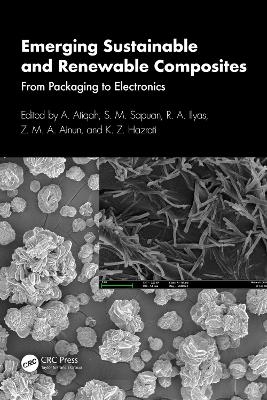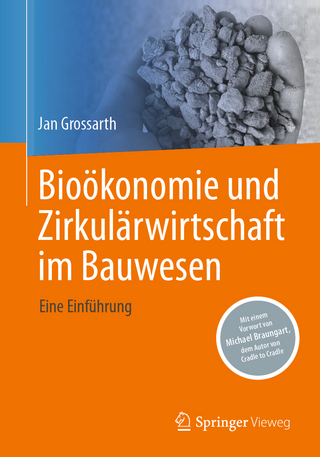
Emerging Sustainable and Renewable Composites
CRC Press (Verlag)
978-1-032-52753-6 (ISBN)
Readers will gain a comprehensive understanding of the development and characterization of sustainable and renewable composites from fibres such as sugar palm, kenaf, sisal, curau, and coir. They will also learn about new potential materials from such fibres and their potential use in various nanoelectronics applications. Each chapter provides recent insight from some of the field’s most prominent industry and academic professionals. Chapter contributors present valuable case studies and describe related environmental issues, environmental advantages, and challenges. Topics include biodegradability, tensile and other physical properties, and applications. Consequently, readers can apply this knowledge to the further development of sustainable and renewable composites toward their global use in place of petroleum-based materials and in new electronics products.
This book is an invaluable and accessible guide for researchers and postgraduate students of composites engineering and nanotechnology who wish to learn more about composites from tropical fibres and their applications. The practical information will benefit those who wish to advance research in this field and promote the adoption of these materials in areas including packaging and nanoelectronics.
A. Atiqah is a Senior Lecturer/Research Fellow at the Institute of Microengineering and Nanoelectronics, National University of Malaysia. She earned a BSc and MSc in materials engineering at the International Islamic University Malaysia in 2011 and 2014, respectively, and a PhD in biocomposites technology and design at University of Putra Malaysia in 2018. She has been recognized as a Top 2% Scientist Worldwide in her field by Stanford University. S. M. Sapuan is Professor (Grade A) of Composite Materials and Head of Advanced Engineering Materials and Composite Research Centre, University of Putra Malaysia. He earned a BEng in mechanical engineering at the University of Newcastle, Australia; an MSc in engineering design at Loughborough University, UK; and a PhD in materials engineering at De Montfort University, UK. He is a Fellow of the World Academy of Sciences, Society of Automotive Engineers International, and Academy of Sciences Malaysia. He has received the SAE Subir Chowdhury Medal of Quality Leadership, International Society of Bionic Engineering Outstanding Contribution Award, the World Academy of Sciences Award in Engineering Sciences, and William Johnson International Gold Medal. R. A. Ilyas is a Senior Lecturer at the University of Technology Malaysia and holds Fellowships with the Institute of Advanced Materials, Sweden and the International Society for Development and Sustainability, Japan. He is a member of the Royal Society of Chemistry (UK), the Institute of Chemical Engineers (UK), and the Chair of Science Outreach for Young Scientists Network – Academy of Sciences Malaysia. He has received several awards, including the MVP PhD Gold Medal Award, Kreso Glavac Special Award (Republic of Croatia; MTE2022), and Outstanding Reviewer recognition. He is listed as a Top 2% Scientist Worldwide for polymer and materials engineering by Stanford University. Z. M. A. Ainun is a Senior Research Officer/Head of Pulp and Paper and Pollution Control Program at the Laboratory of Biopolymer and Derivatives, Institute of Tropical Forestry and Forest Products, University of Putra Malaysia, Serdang, Selangor, Malaysia. She earned a BS and an MS in wood, paper, and coating technology (Hons) at the Science University of Malaysia in 1998 and 2000, respectively, and a PhD in materials science at the National University of Malaysia in 2006. K. Z. Hazrati is a Senior Lecturer at the Industrial Automation Control Section, German-Malaysian Institute. She earned a BS at the Technical University of Malaysia, Malacca in 2011, an MS at the University of Putra Malaysia in 2014, and a PhD at the University of Putra Malaysia in 2022.
1. Analysing the Evolution of Sugar Palm Fiber (Arenga pinnata Wurmb. Merr) Polymer Hybrid Composites: A Review. 2. Environmental Degradation of Natural Fibre–Reinforced Composites. 3. Evaluation of Hybrid Corn Husk Fiber/Hibiscus tiliaceus Fiber Powders–Reinforced Coconut Shell/Polyester Composites: Effect of Volume Fraction on Mechanical and Morphological Properties. 4. Tropical Natural Fibres for Packaging Paper and Its Regulation. 5. Sustainable Substrate Based Biocomposites for Electronic Applications: A Review. 6. A Review on Functionalization and Mechanical Properties of Multiwalled Carbon Nanotubes/Natural Fibre–Reinforced Epoxy Composites. 7. Biodegradable Natural Fibre (Coconut Mesocarp) Filled Polypropylene Composites: Effects of the Compatibilizer and Coupling Agent on Tensile Properties. 8. Tensile Properties of Polypropylene Composites Reinforced by Bio-Natural Fibre (Sansevieria Leaf Fibre): The Effect of Fibre Loading. 9. Sustainable Product Development Using Renewable Composites for Marine Engineering Applications. 10. Seed/Fruit Fibre–Reinforced Composites. 11. Biocomposites from Durian Biomass Wastes: Properties, Characterisation, and Applications. 12. Biomaterials Based on Plant Fibres: Sustainable for Green Composites. 13. Carbonization of Biomass and Waste into Biosourced Carbon (BC) Nanofillers for Advanced Composite Applications. 14. Conducting Biopolymer Composite Films.
| Erscheinungsdatum | 10.07.2024 |
|---|---|
| Zusatzinfo | 59 Tables, black and white; 72 Line drawings, black and white; 72 Illustrations, black and white |
| Verlagsort | London |
| Sprache | englisch |
| Maße | 156 x 234 mm |
| Gewicht | 453 g |
| Themenwelt | Naturwissenschaften ► Biologie ► Ökologie / Naturschutz |
| Technik ► Maschinenbau | |
| Technik ► Umwelttechnik / Biotechnologie | |
| ISBN-10 | 1-032-52753-6 / 1032527536 |
| ISBN-13 | 978-1-032-52753-6 / 9781032527536 |
| Zustand | Neuware |
| Haben Sie eine Frage zum Produkt? |
aus dem Bereich


